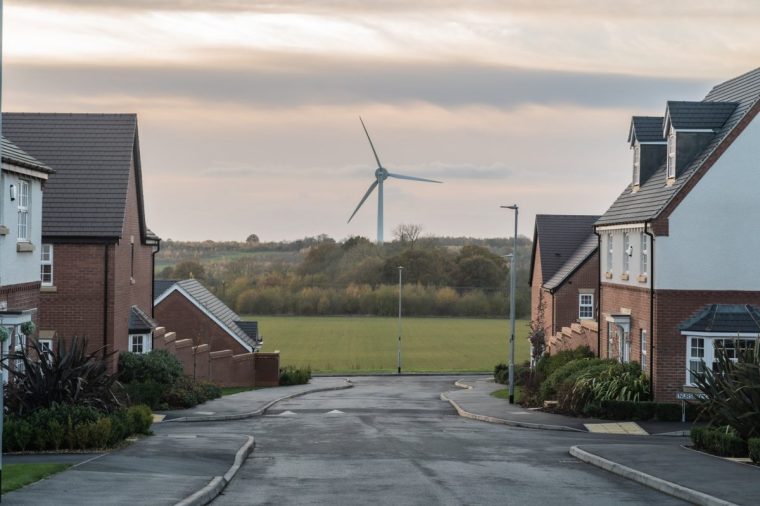Rules on putting a wind turbine in your back garden could be relaxed – but how likely is this to happen?
Rules on putting a wind turbine in your back garden could be relaxed as part of government plans to boost wind output from households, farms and businesses.
At present, detached homes can install a single turbine in their gardens without planning permission – but businesses, terraced and semi-detached homes need it, which acts as a significant barrier.
New proposals are predominantly focussed on boosting wind power generated by businesses by reducing planning restrictions.
But the government is also considering relaxing the rules to give millions of terraced and semi-detached homes the option of installing a turbine – or possibly turbines – in their gardens.
But how likely is this to happen?
Why cost is a major problem
There are currently about 3,400 detached homes in the UK with a certified wind turbine installation in their back garden, according to MCS Foundation, which certifies the quality of renewable energy in UK homes.
These account for the bulk of such installations, although there will be some that are not certified.
Almost all of these were installed before 2016 – before the government stopped paying homes for selling excess wind power into the grid and put an effective ban on onshore wind turbines in England that was only lifted last summer.
These meant that there were only four certified installations in 2024, MCS says.
And although the lifting of the onshore ban in England is expected to drive a surge in large wind farms, very few additional households are likely to take up the opportunity to install a wind turbine.
This is especially the case for terraced and semi-detached homes, which typically have much smaller gardens than detached properties, experts say.
One major deterrent is cost. It is very difficult to be at all precise about costs – in part because it depends on wind speed, the energy efficiency of the home and the size of the turbine.
 The countryside has an advantage because there are fewer buildings to block the wind and more space (Photo: Joe Morris/Getty)
The countryside has an advantage because there are fewer buildings to block the wind and more space (Photo: Joe Morris/Getty)
However, back-of-the-envelope calculations suggest that, even in the most suitable locations, it would cost around £20,000 to £25,000 to install enough wind power to meet an average household’s energy requirements – around 2kW.
That compares to around £4,000 if they installed solar panels to generate the same amount of energy, according to Dr Jonathan Scurlock, Chief Adviser on Renewable Energy and Climate Change at the National Farmers’ Union (NFU) and Visiting Fellow at the Open University, who made the calculations.
Another deterrent is that wind speeds in most UK homes are too low to generate any significant amount of electricity.
“It might work for some, for example isolated cottages in the Scottish highlands where there may be no other electricity source apart from a diesel generator,” Dr Scurlock told The i Paper.
“But if you’re a householder in Surbiton you’re not going to be putting one in your back garden.
“Very few household wind turbines have been put up in people’s gardens because of the turbulent wind ‘regime’ close to buildings and trees – so you won’t generate any significant amount of power.”
Dr Scurlock added: “The small single wind turbines that may get put up for single households will be on a bleak hillside powering maybe a farm cottage but far too small to power the whole farm.”
‘Small wind turbines in gardens rarely make sense’
The countryside also has an advantage over the town because there are fewer buildings to block the wind and more space, experts said.
Jan Rosenow, an Oxford University academic who has advised Ofgem, the International Energy Agency and the European Commission, told The i Paper: “Small wind turbines in gardens rarely make sense because of poor wind conditions, low output, high costs, noise, maintenance needs, and better alternatives like solar.
“They’re more of a novelty or a statement piece than a practical energy solution for most homeowners.”
Energy Minister Michael Shanks said: ”Rolling out more onshore wind is a no-brainer – it’s one of our cheapest technologies, quick to build, supports thousands of skilled jobs and can provide clean energy directly to the communities hosting it.
“After years of decline, we’re giving industry the tools to get building again, backing industrial renewal and secure, clean, homegrown energy through our Plan for Change.”
It is understood that no decision has been made about any rule changes that would make it easier for homes to install wind turbines – but that a variety of measures to do so will be considered.
While wind turbines are not expected to be taken up in any great numbers by households, any changes to the planning rules could have significant benefits for farms and small businesses, experts said.
NFU President Tom Bradshaw said: “Many farmers already generate renewable energy on-site, but reliable power source remains a barrier.
“Updating the planning framework to make it easier to install a single small-to-medium wind turbine – particularly in remote rural areas – would be a practical step that supports on-farm energy resilience while making productive use of the land.”

